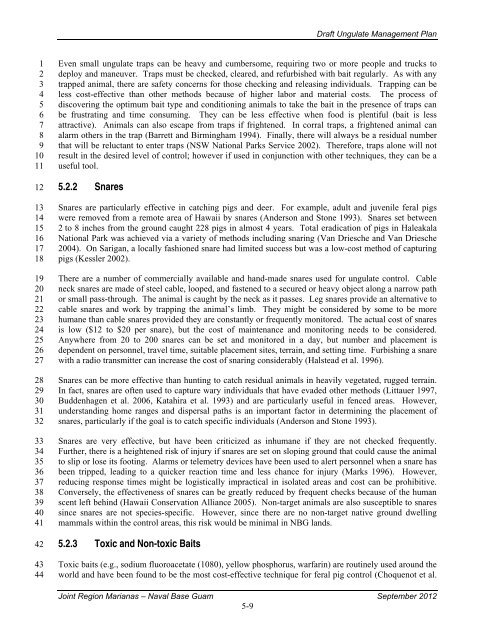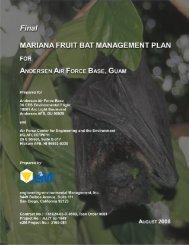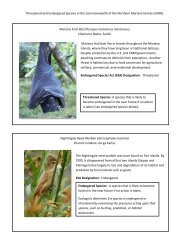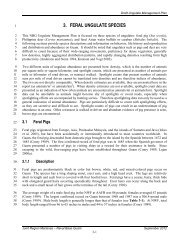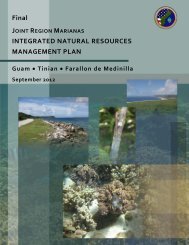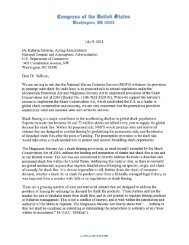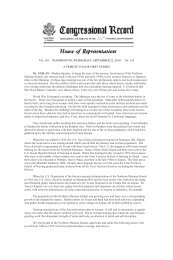4. FERAL UNGULATE SPECIES IMPACTS ON NAVY LANDS
4. FERAL UNGULATE SPECIES IMPACTS ON NAVY LANDS
4. FERAL UNGULATE SPECIES IMPACTS ON NAVY LANDS
Create successful ePaper yourself
Turn your PDF publications into a flip-book with our unique Google optimized e-Paper software.
1<br />
2<br />
3<br />
4<br />
5<br />
6<br />
7<br />
8<br />
9<br />
10<br />
11<br />
12<br />
13<br />
14<br />
15<br />
16<br />
17<br />
18<br />
19<br />
20<br />
21<br />
22<br />
23<br />
24<br />
25<br />
26<br />
27<br />
28<br />
29<br />
30<br />
31<br />
32<br />
33<br />
34<br />
35<br />
36<br />
37<br />
38<br />
39<br />
40<br />
41<br />
42<br />
43<br />
44<br />
Draft Ungulate Management Plan<br />
Even small ungulate traps can be heavy and cumbersome, requiring two or more people and trucks to<br />
deploy and maneuver. Traps must be checked, cleared, and refurbished with bait regularly. As with any<br />
trapped animal, there are safety concerns for those checking and releasing individuals. Trapping can be<br />
less cost-effective than other methods because of higher labor and material costs. The process of<br />
discovering the optimum bait type and conditioning animals to take the bait in the presence of traps can<br />
be frustrating and time consuming. They can be less effective when food is plentiful (bait is less<br />
attractive). Animals can also escape from traps if frightened. In corral traps, a frightened animal can<br />
alarm others in the trap (Barrett and Birmingham 1994). Finally, there will always be a residual number<br />
that will be reluctant to enter traps (NSW National Parks Service 2002). Therefore, traps alone will not<br />
result in the desired level of control; however if used in conjunction with other techniques, they can be a<br />
useful tool.<br />
5.2.2 Snares<br />
Snares are particularly effective in catching pigs and deer. For example, adult and juvenile feral pigs<br />
were removed from a remote area of Hawaii by snares (Anderson and Stone 1993). Snares set between<br />
2 to 8 inches from the ground caught 228 pigs in almost 4 years. Total eradication of pigs in Haleakala<br />
National Park was achieved via a variety of methods including snaring (Van Driesche and Van Driesche<br />
2004). On Sarigan, a locally fashioned snare had limited success but was a low-cost method of capturing<br />
pigs (Kessler 2002).<br />
There are a number of commercially available and hand-made snares used for ungulate control. Cable<br />
neck snares are made of steel cable, looped, and fastened to a secured or heavy object along a narrow path<br />
or small pass-through. The animal is caught by the neck as it passes. Leg snares provide an alternative to<br />
cable snares and work by trapping the animal’s limb. They might be considered by some to be more<br />
humane than cable snares provided they are constantly or frequently monitored. The actual cost of snares<br />
is low ($12 to $20 per snare), but the cost of maintenance and monitoring needs to be considered.<br />
Anywhere from 20 to 200 snares can be set and monitored in a day, but number and placement is<br />
dependent on personnel, travel time, suitable placement sites, terrain, and setting time. Furbishing a snare<br />
with a radio transmitter can increase the cost of snaring considerably (Halstead et al. 1996).<br />
Snares can be more effective than hunting to catch residual animals in heavily vegetated, rugged terrain.<br />
In fact, snares are often used to capture wary individuals that have evaded other methods (Littauer 1997,<br />
Buddenhagen et al. 2006, Katahira et al. 1993) and are particularly useful in fenced areas. However,<br />
understanding home ranges and dispersal paths is an important factor in determining the placement of<br />
snares, particularly if the goal is to catch specific individuals (Anderson and Stone 1993).<br />
Snares are very effective, but have been criticized as inhumane if they are not checked frequently.<br />
Further, there is a heightened risk of injury if snares are set on sloping ground that could cause the animal<br />
to slip or lose its footing. Alarms or telemetry devices have been used to alert personnel when a snare has<br />
been tripped, leading to a quicker reaction time and less chance for injury (Marks 1996). However,<br />
reducing response times might be logistically impractical in isolated areas and cost can be prohibitive.<br />
Conversely, the effectiveness of snares can be greatly reduced by frequent checks because of the human<br />
scent left behind (Hawaii Conservation Alliance 2005). Non-target animals are also susceptible to snares<br />
since snares are not species-specific. However, since there are no non-target native ground dwelling<br />
mammals within the control areas, this risk would be minimal in NBG lands.<br />
5.2.3 Toxic and Non-toxic Baits<br />
Toxic baits (e.g., sodium fluoroacetate (1080), yellow phosphorus, warfarin) are routinely used around the<br />
world and have been found to be the most cost-effective technique for feral pig control (Choquenot et al.<br />
Joint Region Marianas – Naval Base Guam September 2012<br />
5-9


